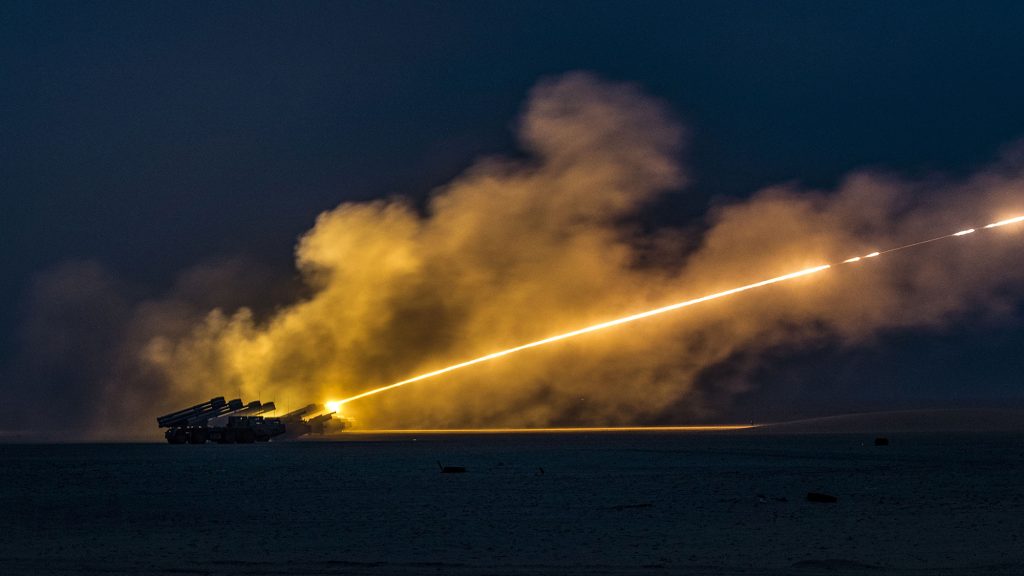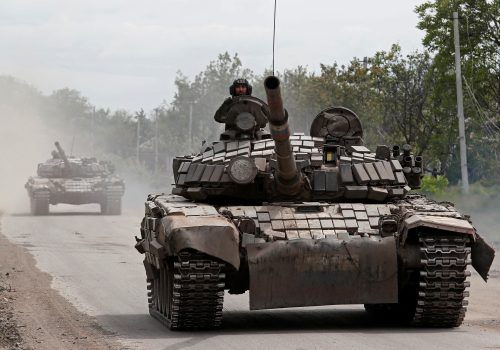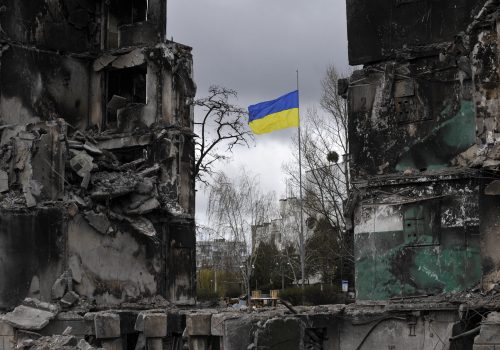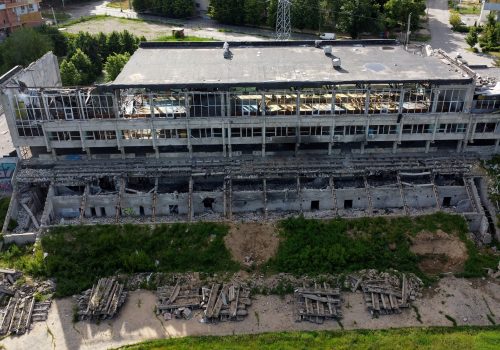In light of the ongoing Russia crisis, the Scowcroft Center’s Forward Defense (FD) practice will share weekly assessments of the latest force developments surrounding Ukraine, leveraging the expert perspectives of our senior military fellows. The opinions, conclusions, and recommendations expressed or implied here are solely those of the authors and do not represent the views of the Department of Defense or any other US government agency.
The bottom line
While the transfer of US high mobility artillery rocket systems (HIMARS) and British multiple launch rocket systems (MLRS) will help Ukraine, we assess that the amount of systems and ammunition planned for transfer in the first tranche will only have a minor impact in the fighting.
Russia’s campaign in the Donbas region is reaching a standstill, with its numerical advantage in forces and fires effectively countered by Ukraine’s tactical employment of battlefield intelligence.
The race to resupply troops at the frontlines remains the linchpin for military success on both sides. As Russia sends more conscripts to support the Donbas campaign, Ukraine will focus on reinforcing logistical supplies and moving ground-based systems to the front lines.
The Russian offensive
The Kremlin’s Donbas campaign—which has focused on massing Russian troops and firepower around Severodonetsk in an attempt to capture the strategically vital city—appears to have slowed to a halt. Limited Ukrainian counterattacks have reclaimed small areas around the city and, as of publication, we assess that the risk of encirclement and destruction or capitulation of Ukrainian forces there has receded. Although Russia maintains a numerical superiority in forces and advanced weapons in the region, Ukrainian forces have mitigated that advantage by using battlefield intelligence—such as the sinking of the Russian cruiser Moskva and the Ukrainian ambush of the Russian battalion crossing the Siverskyi Donets River—to direct precision fires and stop Russian advances, stop reinforcements and resupply, and direct localized counterattacks. The Donbas campaign is nearing a bloody stalemate, with the line of control in the Donetsk and Luhansk oblasts staying essentially unchanged over the course of days and even weeks.
The Russian flow of forces and fires to the area around Severodonetsk aims to break the Ukrainian resistance, which would allow the Kremlin to encircle Ukrainian forces in the Severodonetsk salient. This leads us to believe that Russia’s objective is to annihilate the major Ukrainian fighting force in the Donbas, allowing Russia to take most, or all, of the Donetsk and Luhansk oblasts. For their part, Ukrainian forces will press forward with their precise application of fires to stall Russian momentum and prevent resupply of Russian front-line forces. Additionally, they will continue to execute limited counterattacks with the objective of extinguishing Russian resistance in order to retake large swaths of land and move the line of control much closer to the Russian border.
As has been the case since the start of the Donbas campaign, the race to resupply will be critical for both sides. To replace its losses, the Kremlin may need to resort to sending in thousands more conscripts. Meanwhile, Ukraine must maintain its logistics lines and move ground-based fires forward, including long-range artillery, MLRS, and unmanned aerial systems.
Subscribe to our military assessments
Sign up for updates from Forward Defense to hear the latest on the trends, technologies, and military challenges shaping tomorrow.
US and allied support for Ukraine
US delivery of rocket systems to Ukraine. On June 1, the US Department of Defense (DoD) announced a new $700-million tranche of security assistance to Ukraine. The highlight of this package was the first pledge of US-made multiple rocket launchers, for which the Ukrainian military and government has been clamoring since the start of the conflict—with added urgency as the Donbas campaign has progressed. DoD announced the deployment of four HIMARS launchers and associated ammunition, including the Guided Multiple Launch Rocket System (GMLRS), which is capable of hitting targets beyond forty miles.
- Importance of HIMARS. As the scope of the war in Ukraine has narrowed to a battle of attrition over Donbas, the ability to bring firepower to bear has increased the importance of long-range fires. In the previous tranches of security assistance, the United States had sent 108 of the 155mm Howitzer long-range artillery pieces and more than 220,000 155mm artillery rounds. The 155mm Howitzer has a fifteen-mile range, so the HIMARS is now the longest-range system the United States has transferred to Ukraine. Each system is capable of firing six GMLRS rockets or one Army Tactical Missile System (ATACMS) missile (which the United States has not yet agreed to transfer).
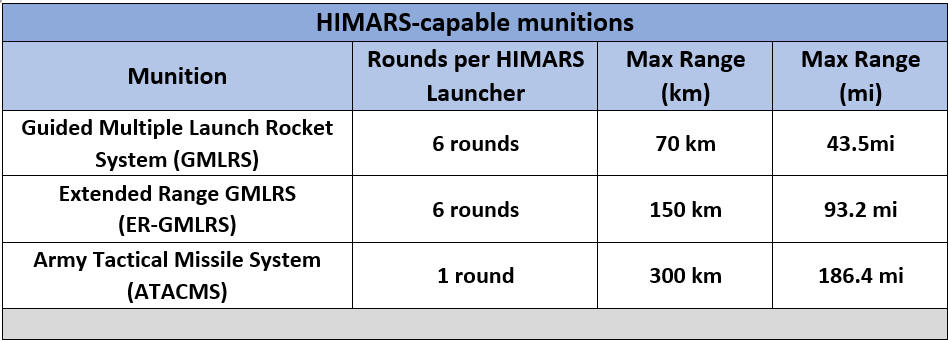
- Administration avoids sending long-range HIMARS munitions. The Biden administration was clear that it was not sending the longest-range HIMARS munitions, either the Extended Range (ER)-GMLRS (93+ mile range) or the ATACMS (186+ mile range), in order to prevent Ukraine from striking targets inside Russia. While this arguably mitigates the risk of escalation, it means Ukraine’s four HIMARS launchers must be moved within forty miles of the Donbas front—or closer, if Ukrainian forces choose to target Russian reinforcements or resupply lines behind the front. The HIMARS launchers could therefore be targeted by Russian air, missile, or rocket attack.
- Potential future HIMARS transfers. Although the transfer of HIMARS will enhance Ukrainian precision fires, the small number of launchers and the failure to transfer either the ER-GMLRS or ATACMS munitions limit the effect of this transfer, leading us to believe that HIMARS will not have a decisive effect on the Donbas campaign. That said, the Biden administration slowly ramped up its transfer of 155mm Howitzers, initially announcing the transfer of eighteen of the long-range artillery systems. The muted Russian reaction may have encouraged the administration to take a more aggressive stance by sending another ninety guns. It may be evaluating Russia’s reaction to the initial tranche of four HIMARS launchers and GMLRS munitions before announcing a further tranche of launchers and either the ER-GMLRS or ATACMS, or both. We assess the HIMARS could be decisive in the Donbas fight given a significant increase in the number of launchers. Further, the transfer of the ER-GMLRS munitions would enhance Ukraine’s ability to strike targets behind the front lines and enhance the survivability of those launchers.
The United Kingdom sends MLRS systems. On April 6, British Defense Secretary Ben Wallace announced plans to send tracked MLRS systems to Ukraine (initially three). The MLRS is the older, bigger brother to the HIMARS system. It features two six-pack rocket pods per carrier. Its tank-like chassis gives it more maneuverability in rough, muddy terrain, although it features slower speeds than the HIMARS wheeled systems.
NATO remains wary of risks of escalation. NATO is still trying to decide whether it will give Ukraine the weapons it needs to win the war decisively or to supply just enough to extend the war in hopes of a Russian withdrawal. Ukraine has extended this war longer than expected, and Russian President Vladimir Putin has warned the Alliance multiple times about the risks of escalation if itsupplies weapons to Ukraine. It is unclear what might provoke escalation by Russia–such as the threat of a tactical nuclear strike. If Russia begins to cede ground to Ukraine in large amounts, we assess that the risks of escalation increase dramatically.
- Extended-range rockets. Putin’s warnings have already impacted NATO countries’ decisions about supplying fighter jets; it appears they have also delayed the supply of advanced rocket systems. But now that the United States and other NATO countries have accepted the risk of supplying these weapons, they face a decision about whether to continue holding back their full capabilities, namely supplying extended range rockets such as the GMLRS-ER and the ATACMS.
- Rocket supplies. The Biden administration announced that it initially plans to send forty-eight rockets to Ukraine. This is an extremely low quantity, considering the threat Ukraine is facing. Rocket supplies by the United States, the United Kingdom, and NATO must be increased substantially to significantly help Ukraine.
- Number of systems. The number of rocket systems announced by the United States and United Kingdom to date are mostly symbolic. Ukrainian officials recently stated that sixty launchers would stop Russian forces, forty would slow them down, and that twenty would have only minor battlefield impacts.
FD’s conclusion
If the battle in eastern Ukraine becomes a war of attrition, the Russians are currently favored to win. In addition to having a much larger population from which to draw replacement forces, Russia knows that Ukraine is dependent on older, Russian-made tanks and fighters. While Poland recently gave Ukraine 240 of its old T-72s, the donation of old equipment from former Warsaw Pact members is only a temporary solution. To help Ukraine expel Russian forces from its territory—and defend itself in the future—the United States must begin its full transition to US-made equipment now. That means Washington should send M1 Abrams tanks, F-16 fighter jets, light armored vehicles, and helicopters. We believe this should be accompanied by renewed US statements that it will not intervene militarily in the conflict, to assuage Russian fears.
Meet the FD team
Today’s briefing is brought to you by senior US Army fellow COL Benjamin Johnson, senior US Air Force fellow Lt Col Tyson Wetzel, and senior US Marine Corps fellow Col J.B. Barranco. The Scowcroft Center Military Fellows Program, housed by the Forward Defense practice, hosts military fellows from participating branches of the US military and the armed forces of US allies and partners each year as part of a twelve-month fellowship program.
Further reading
Wed, Jun 8, 2022
Belarus bluff? Putin’s only ally sparks fears of possible new Kyiv offensive
BelarusAlert By Peter Dickinson
Intensifying military activity in southern Belarus is fueling speculation over a possible renewed Russian assault on Kyiv but the true objective may be to tie down Ukrainian troops and prevent redeployment to eastern Ukraine.
Mon, Jun 6, 2022
Russia has not abandoned its goal of crushing Ukrainian statehood
UkraineAlert By Melinda Haring
Ukraine has achieved a number of striking successes during the first phase of the Russian invasion but there is no room for complacency as Vladimir Putin's goal of crushing Ukrainian statehood remains unchanged.
Sun, Jun 5, 2022
It’s time to show Putin a dead end in Ukraine, not an off-ramp
Inflection Points By Frederick Kempe
The West needs to pursue a Ukrainian victory, and offering Putin an off-ramp instead would be a big mistake.
Image: Handout file photo dated Januart 8, 2019 of U.S. Soldiers assigned to the 65th Field Artillery Brigade, and soldiers from the Kuwait Land Forces fire their High Mobility Artillery Rocket Systems (U.S.) and BM-30 Smerch rocket systems (Kuwait) during a joint live-fire exercise. Joe Biden has announced the US will send advanced missile systems to Ukraine. The new weapon is the Himars multiple launch rocket system, or MLRS: a mobile unit that can simultaneously launch multiple precision-guided missiles. Both Ukraine and Russia already operate MLRS, but Himars has superior range and precision. U.S. Army photo by Sgt. James Lefty Larimer via ABACAPRESS.COM
